monday.com is the easiest project management software to operate, thanks to intuitive drag-and-drop functionality, impressive customization options, and a constantly evolving feature package – which includes a raft of time-saving AI capabilities.
Picking the right software program for your team isn’t always easy, especially if you’re a small business without much of a software budget. However, you’ll feel instantly more organized with monday.com thanks to the software’s clean and tidy interface. What’s more, if you’re on track to expand your team and operations, monday.com can grow with you – it offers a free plan and four paid plans for businesses of different sizes.
Having used monday.com extensively in a number of different roles, I’m extremely familiar with the platform’s feature set and its strengths and weaknesses for different use cases. I’ve used these personal insights – alongside the wealth of data collected by our structured research – to create this comprehensive monday.com review. Scroll on to learn more about the popular project management platform, and to determine whether it’s right for you.
monday.com is a cloud-based project and work management platform geared towards planning and managing projects and tracking day-to-day workplace activities, tasks, and duties. As tools for project management go, it’s extremely easy to use, with a clean interface, helpful instructions, and intuitive tools that don’t take long to master.
It also has a wide range of advanced features like a workload view for keeping a close eye on your project’s progress and team duties, and one of the best dashboard builders in the industry, helping it to a 5/5 score for data visualization.
 💻 monday.com has a 20% discount available for startups right now 👌 📈
💻 monday.com has a 20% discount available for startups right now 👌 📈
Find out if you're eligible today.![]()

The “My Work” view on monday.com gives you an oversight of all of your tasks, no matter which board they might sit on. Personally, I rarely use this view. Source: Tech.co testing
Thanks to its customizability, monday.com is a solid option for a wide variety of teams, from those who just want a central place to track their daily work tasks to larger teams who want to streamline processes and mechanisms at scale.
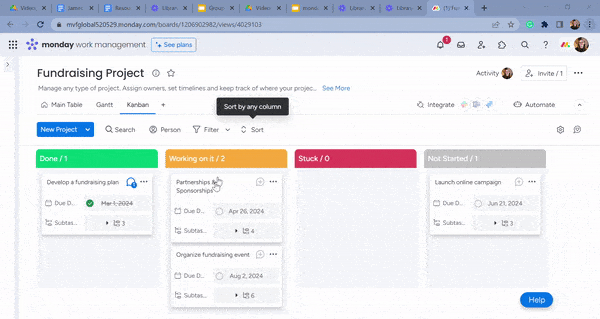
Monday.com’s Kanban board was easy to use, and let me view our lists of tasks at a glance. Its cards are fully customizable, and I was able to create new items to add to the board in a flash. Source: Tech.co’s testing process
monday.com has a straightforward automation builder that is easier to use than ClickUp’s and a genuinely helpful and highly responsive live chat function for sussing out where you’ve gone wrong. There’s also a really useful, customizable “Chart” area for project insights, as well as a Kanban board, a time-tracking feature and a classic grid/table view.
Overall, monday.com performed extremely well in our most recent round of project management testing, making it our top project management provider for last year – in 2023, it came a close second to ClickUp. monday.com especially impressed us when it came to usability and data visualization, performing better in these categories than any other provider we tested. This makes it perfect for anyone new to digital project management.
Test Summary
monday.com feels like it’s been built with newbies in mind, and the clever use of white space instantly makes your workspace feel organized and uncluttered.
Setting up didn’t take very long – I finished both the data import and setting up my project views much more quickly than I did wen we ran our test with Smartsheet. The automation builder is a good example of monday.com’s simplicity advantage – while Wrike’s automation builders both felt restrictive and tricky to configure, monday.com’s was more flexible and easier to create useful automations with.
I was particularly impressed with the customer support experience – the live chat function is really useful, and a member of monday.com’s support team even sent me a video showing me where I was going wrong at one point.
By far my favorite day-to-day monday.com feature is the way it’ll auto-save a task comment for the next time you return, even if you haven’t posted it yet – this has saved me so many times and makes quick collaboration that bit easier!

monday.com Pros and Cons
monday.com has some useful advantages that helped it secure top spot in our recent project and task management software testing series. It’s not a perfect software program either – and it wouldn’t be a monday.com review without some honest pros and cons.

monday.com is highly customizable, but definitely built with the general user in mind. It doesn't take a tech whiz to quickly master its menus or create custom automations. There are lots of support options on hand if you get stuck, including a live chat function that we found very useful.
- Free plan available

- Basic plan: $9/user/month

- Standard plan: $12/user/month

- Pro plan: $19/user/month

- Enterprise plan (contact sales for pricing)

monday.com pros:
- ‘Custom Fields’ feature available on all plans
- Rule-based automation for simple tasks
- More than 200 project templates
- Modern, minimalistic user interface
- Free plan available for solo users and duos
- Quicker to set up than Wrike and Jira
- Highly responsive live chat feature
- Easy to add budgeting information to tasks
monday.com cons:
- Task filtering tools can be a little restrictive
- The “My Work” area isn’t that useful
- Time tracking only on Pro plan
- The mobile app isn’t as functional
- Onboarding questions aren’t straightforward
- The dashboard feature needs more guidance
As our favorite project management tool, we have a lot of good things to say about monday.com. First up, it looks great. The interplay between white space and tasteful use of color adds up to a intuitive, uncluttered interface, which is easy to navigate due to clear signposting.
When it comes to task management, you’re really spoilt for choice – monday.com offers several different available views, including Kanban, timeline, calendar, map, and chart. Some of these are reserved for pricier plans, but monday is pretty reasonably priced – roughly speaking, it falls middle of the pack when compared to other options on the market.
First-time project management users might initially be a little daunted by the sheer depth of functions, but you’ll quickly become acclimatized. Drag-and-drop functionality makes it simple to move your tasks through different stages of completion, and the live chat feature is always on hand to help if you get stuck.
“I like monday.com as it’s a really simple project management tool– you don’t need an introduction, you can just start using it. You can share boards with people who don’t have access to monday.com with a view-only link, and lots of the automations save time when planning and keeping organized.” – Aimee Irvine, an outreach specialist who recently worked with tech.co and uses monday.com to organize her team’s work.
Aimee also told us: “I also like being able to save many filtered views of a board, which makes it easier to find information, and the Kanban board is good for understanding task progress, too.”

I appreciate how easy monday.com makes it to move tasks around beyond the Kanban board. You can just grab them and move them to different locations as you see fit. Source: Tech.co user testing
As we’ve said, however, monday.com isn’t perfect. “I don’t really like the ‘my task’ view,” Aimee continued, echoing a frustration we experienced when we tested monday.com. “It has very limited functionality so being able to see all my tasks from multiple boards is difficult unless there is a deadline assigned to every task.
She continued, “I also don’t like how the same task cannot exist on two boards without it just being a duplicate of the task. This results in having to manually update two tasks if you make any changes to one as they are not the same item/linked tasks.”
monday.com Review: Key Features and Test Results
monday.com is one of the best project management tools on the market for functionality. While it might not have the feature set included in ClickUp, monday.com hits that sweet spot between having genuinely useful tools and not becoming overwhelming or unnecessarily complicated.
On our last round of testing, monday.com scored highly compared to other providers when it came to features, with a score of 4.2/5 overall for functionality. Below, we’ve outlined some of our favorite features.
In this section:
Setting up with monday.com
Like most other project management tools, monday.com starts with a “main workspace” at the very top. Under that are what monday.com calls “boards.” When testing the platform, I worked on a one-board-per-project principle and this seemed to work just fine for my test project, which revolved around the key elements of launching a website.
After you log in and create a workspace, you’ll be asked if you want to import any project data from another program (Excel, Google Sheets, etc.), which was a pretty smooth experience all things considered – this isn’t always the case with all project management tools.

Importing data into monday.com was smooth and it took a lot less time that it did when I tested other project management platforms. Source: Tech.co testing
After your data is imported (which took very little time), the software will present you with a view called the “Main Table” where you can add the different tasks you need to complete.
monday.com layout and project views
You might think monday.com’s color coding is a little blinding at first, but customizing the main table is actually super easy to use. All you have to do is add columns that serve different purposes, and you can just grab individual tasks by clicking them and group them as you please.

monday.com let me create different task groups easily. I was also able to customize the columns by adding milestones, receipts, deadlines, and timelines, making it more tailored to my needs. Source: Tech.co testing
The functional columns are very general, and you can effectively turn them into anything you want. Inserting a currency symbol, for example, will turn it into a money/budget column for you. Alternatively, you could make it a column for estimating the time needed to complete the task. It’s very much like a sandbox – you can ask yourself what you need and create it yourself.
However, monday.com offers a huge range of additional views (over 15 in total) that I could use for oversight, such as a calendar, a Gantt chart, and a workload view.

monday.com also let me view my workload using a Gantt chart view. This was useful because it gave me a greater understanding of the project timeline. Source: Tech.co testing
Although I had to play around with the Gantt chart for a minute (and consult monday.com’s live chat), all the data I needed from my main table was already there – I just needed to select it. I then turned on the “critical path” function to highlight the most important tasks in my project, which is a relatively new feature.
The workload view, on the other hand, really clearly shows which team members have the longest to-do lists. Another recent monday.com feature is the ability to accurately define and divide up effort, which puts it on par with Wrike, a software tool known for its workload-tracking capabilities.

monday’s workload view clearly showed me which members of the team had the longest to-do list, and which tasks belonged to different phases of the project. Source: Tech.co testing
monday.com’s filtered views feature does have limitations. For example, I didn’t initially realize that you can move views that you’ve created along the top of the of your interface. For a while, I thought that if you created a new view in a board, it will remain stuck in a default position. However, it turns out you can move them, it’s just not immediately obvious how to do so.
Furthermore, when I was first starting to use monday.com and was working solely out of the Main Table view, I made the mistake of filtering on my own name and saving it as a new default view. This meant that any team members that wanted to look in our board were automatically presented with my work only. This caused a lot of confusion, but after a relatively short time we were able to get to the bottom of the problem and resolve it. Still, I did think that it was a little too easy for users who might be unfamiliar with the platform to make the same mistake.

The “Save as new view” prompt can be confusing for first-time users, as I learned. Source: Tech.co testing
Managing tasks with monday.com
Part of what makes monday.com such a multifunctional platform is its array of task management features. As we’ve discussed already, one of the reasons it achieved such a high score is the huge range of views you can use to secure top-level oversight over task progress – there are more than 15 in total.
I found the more detailed elements of task management pretty simple too. When I clicked on specific tasks, I was able to peruse the activity log, attach files, and leave comments and @ other team members. You can also attach files and peruse the task history to get yourself up to speed.

The monday.com Kanban board, which gives you visibility of all your tasks, including key stakeholders and deadlines, at a glance. Source: Tech.co testing
The bottom line is that you can mold tasks into containers of information that suit your needs – and it doesn’t take a tech whizz to get to grips with it quickly, either. Granted, it’s not quite as powerful or customizable as arch-rival ClickUp’s task management area, although there’s a nice invoice function that makes keeping track of spending much easier.

monday.com let me set up an invoice for a task and input specific budget information. I could also use the feature to log client information. Source: Tech.co testing
Unfortunately, when I was using monday.com, I found that some of the advanced task management features, such as task dependency and time-tracking tools, are only available on the Pro ($19 per user, per month) and Enterprise (no public pricing) plans.
What’s more, Gantt charts aren’t available on monday.com’s free plan, while milestones, task dependencies, and a calendar aren’t available on the Basic plan. By contrast, you can get Gantt charts on the ClickUp free plan, although it is capped at 60 uses.
Rival project management software tool Teamwork also excels in this area, netting a 4.3/5 score for task management. Teamwork’s Deliver plan ($10.99 per user, per month) includes a time tracking tool and a task dependency feature. Teamwork used to have a Starter plan which retailed at just $5.99, and also offered time tracking and task dependencies, but this was discontinued in 2024.
Building automations in monday.com
monday.com’s automation builder and selection of pre-set and custom templates were comprehensive, but they didn’t blow us away. The software recently scored slightly worse in this testing category compared to our last round of testing in 2022.
This is partly because rivals like Teamwork have upgraded their automation capabilities since our last tests. That being said, monday.com still has one of the simplest automation builders in the game.
As you may be able to tell from the automation center options, monday.com will carry out particular actions for you after something else happens:

monday.com has a range of pre-built task automations, and the software also let me create custom automations for specific workplace processes. Source: Tech.co testing
What that “something” is depends on how you program it. You to create an automated task in plain language – for example, I created an automation that makes sure I’ll be notified if the phase status of any task is changed to “quality assurance phase”:
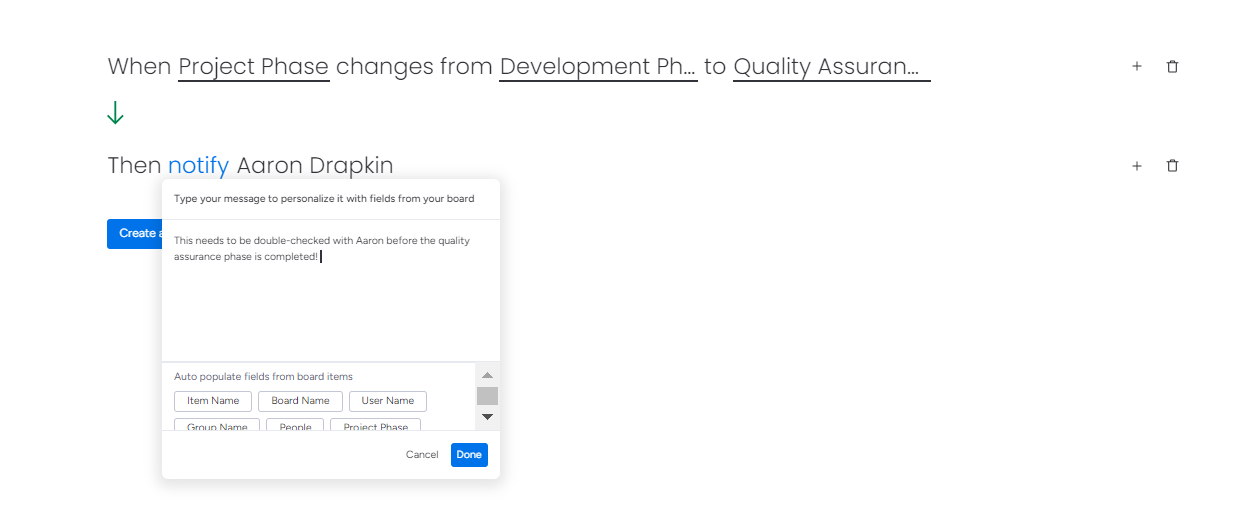
I created a custom automation using monday.com and personalized it with a message. Source: Tech.co testing
Automations have their limits, however. In the version of monday.com we used during testing, we couldn’t set automations for specific tasks, such as “when Task 1 is done, alert person in charge of Task 2.” Our way around this was to add a new status column, rename it “dependency,” and then edit it to have only two statuses: “not ready” and “ready.”
We then created an automation to notify another team member when the dependency column changed from “not ready” to “ready.” That way, only tasks using the dependency column would activate this automation. In other words, our solution worked but required more tinkering than some users may be happy with.
monday.com can be a little trigger-happy with the feature too. Sometimes when I made a custom automation, the software put the changes into action before I was finished editing it. While this didn’t pose too much of an inconvenience, it could be annoying if users needed to add lots of details to each automation.
If automation is your main priority, we’d recommend taking a look at Teamwork – our research team thinks its automation builder is easier to use than monday.com’s, although they both function quite similarly.
Collaborating with your team in monday.com
If monday.com has a weak point, its collaboration – although it scores a decent 3.3/5, it’s not got quite the range of accessible tools for communication as the likes of ClickUp.
monday.com’s whiteboard tool, for instance, has traditionally been useful for interactive sessions to pool stakeholder views – but this feature is now being retired, which is one of the reasons that monday.com lost out to ClickUp when it comes to collaboration.
There is a document editing tool, however, and a project message board for discussions. If you want a proper chat “view” that can be added to your bookmark bar, however, you’ll have to download a monday.com app, such as the chat app we downloaded:

When using monday.com, I could send messages to my team in real time using the software’s Team Chat Room feature. This makes monday.com a great choice for teams looking to collaborate from afar. Source: Tech.co testing
One useful collaboration feature, however, is that monday.com allows you to make your project read-only and grant guest access to anyone who may need to view it, which is ideal if you have stakeholders who aren’t directly involved in the project but would still benefit from being able to view your work.
Apart from this, the only real feature for collaborating with your team in monday.com is commenting on task cards. While slightly rudimentary, it’s a very effective way of keeping on top of task progress with your teammates. In the image below, you can see a conversation between myself and some of my colleagues. When it comes to a particular piece of work, keeping all of our comms in one place is a neat way to make sure nothing important gets missed out.

Task card comments are arranged in an ascending vertical view for ease of viewing. Source: Tech.co testing
monday.com’s third-party integrations
monday.com scores 4/5 for integrations, and has a decent-sized library of apps it can sync up with. However, it’s not as impressive as Wrike’s (4.8/5) and Asana’s (4.7/5), which both offer larger, more relevant selections.
Naturally, monday.com integrates with commonly used services like Gmail, Teams, and Slack, but there’s also a wide range of marketing, CRM, finance, and reporting integrations available.
We use both monday.com and Slack here at Tech.co, so I decided to enable the integration on the monday.com end. It was simply a matter of navigating to the app store, searching for “Slack,” and enabling installation. I was impressed with how quick and seamless the whole process was.
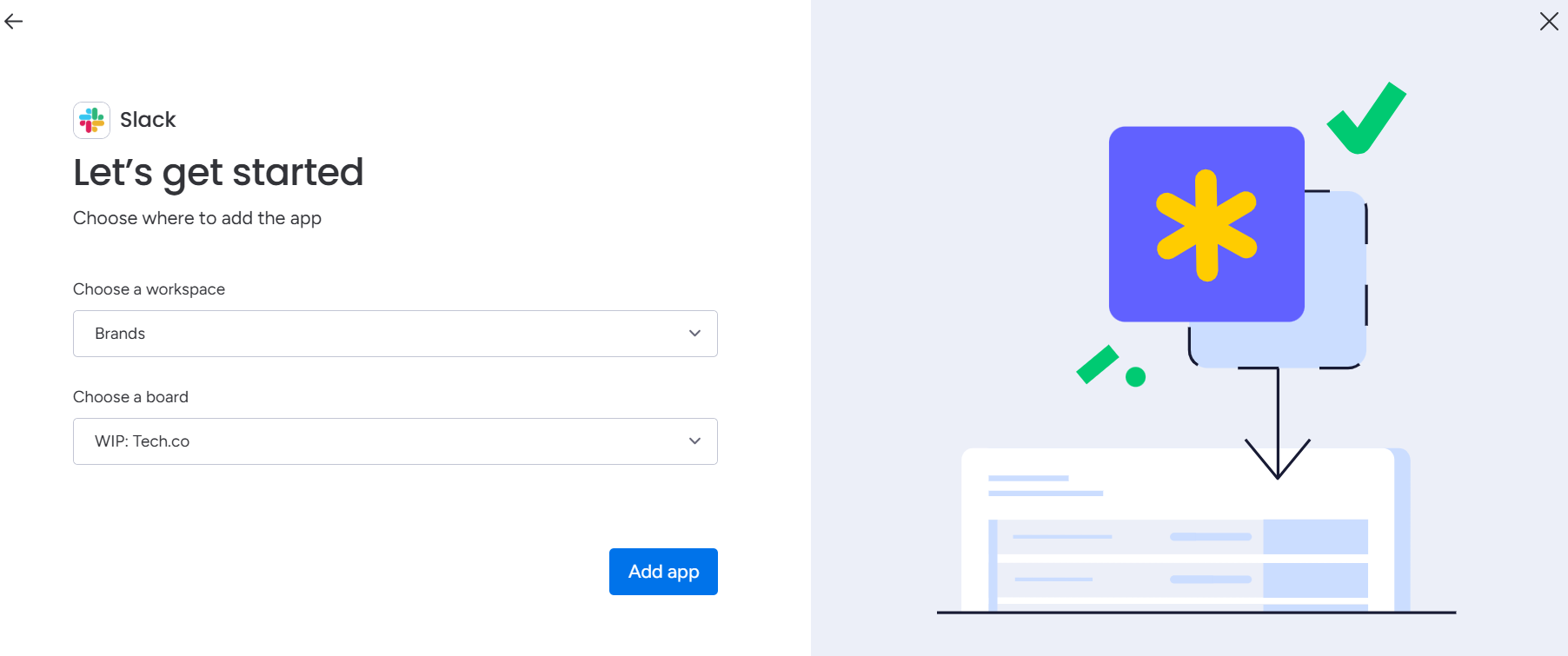
During setup, monday.com will ask which workspace and board do you want to pull information from. Disappointingly, you can’t pull information through from multiple workspaces, but depending on how your organization uses monday, this is unlikely to be an issue. Source: Tech.co testing
The Gmail integration allows you to create a new task when an email is received from a particular contact. along with a variety of other triggers for actions. Alternatively, you could use a Slack feature that notifies people in a particular channel (chat room) when a new pulse is created. If all you need from Slack and Gmail are these two features, then that’s all you have to add.

monday.com’s Gmail integration let me create a new task when an email was received by a specific contact, which was a great way to streamline communication across platforms. Source: Tech.co testing
You’ll also be able to integrate with other teams in your business using other project management software tools, as monday.com integrates with Asana and can be hooked up to ClickUp via Zapier.
However, there are no integrations available on monday.com’s Free or Basic plan – the $12 per user, per month Standard plan is the cheapest monday.com plan that can integrate with other software.
Viewing project data in monday.com
Thanks to monday.com’s Chart view, which was extremely useful for visualizing project data, monday.com was awarded 5/5 for this assessment category by our research team. This was the best score achieved out of the 10 providers we tested.
The Pro plan is the most fully featured monday.com plan from a data visualization perspective, with 6 preset charts to choose from as well as the ability to make your own. However, you can create widgets, which can be used to display specific metrics, on the Basic and Standard plans.
There’s also a chart view, allowing users to get a global view of their various boards with bar charts, timelines, and so on. In fact, monday.com scores 5/5 for data visualization, putting it joint first with ClickUp, Asana, and Wrike.

I was able to build a custom dashboard on monday.com, containing all the widgets that were important to me like Board Updates, Chart views, and more. Source: Tech.co testing
On monday.com’s cheaper plans, you’ll still be able to build widgets and display them on a dashboard. Some competitors, like Trello, only offer limited data display tools on their most expensive plans, so didn’t score as well (2.9/5) in this category.
Jira, however, actually has a full suite of data visualization tools on every plan, including its free version – although it’s a bit more of a steep learning curve than monday.com, in many instances.
Customer support and security options in monday.com
monday.com’s support options are reasonably varied, and my personal experience with using the live chat function was particularly positive. After running into an issue and contacting a customer service agent, they promptly sent me a Loom video via email showing me precisely what I had to do to rectify my problem.
The speed of the response was very reassuring, and this experience – plus the company’s 24/7 live support, which some providers like Wrike don’t offer – helped monday.com achieve an impressive 4.5/5 score.
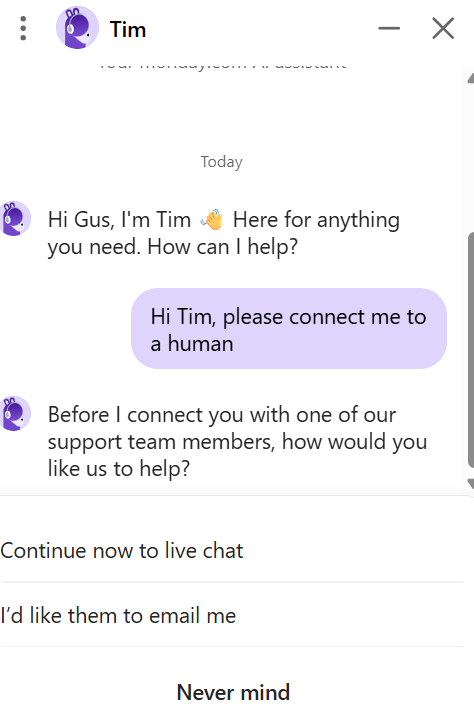
AI chatbots are notoriously unwilling to connect you to a human operator, which I find immensely frustrating. That isn’t the case with monday.com, which was willing to connect me after one simple prompt. Source: Tech.co testing
Along with the live chat function, you can contact the company for help via email, and there’s also a knowledge base and community forum to refer to if you feel like you can fix the issue independently. There are quite a few video tutorials for users to refer to as well if your problem doesn’t demand a direct channel of communication.

monday.com’s knowledge base allowed me to resolve any queries I had when using the platform. I could also use the live chat function when I needed more targeted support. Source: Tech.co testing
monday.com’s Enterprise plan is the only plan that comes with premium support, and larger businesses will appreciate this if they get stuck with some of the more complex enterprise-level features. There’s also onboarding assistance to help you and your team get set up.
In terms of security, monday.com has 2-factor authentication available on all paid plans, as well as a guest access function on the Standard, Pro, and Enterprise plans. There are also IP restriction capabilities included on the Enterprise plan, which not a lot of competitors offer, helping monday.com earn its status as one of the best project management platforms for keeping data secure.
What’s new for monday.com for 2025?
monday.com is adding new features to its software every month – and take it from us, not everyone is updating and iterating as much as monday.com is. Programs like Trello simply don’t get new features and functions at the same pace.
In November, for instance, the platform introduced the “Autopilot hub.” Embedded within the left-hand navigation column, this centralizes all of your automations, integrations, and workflows to give you an overview of how they’re working together. Previously, you would have to navigate to the board automation pages, which only provide information on the specific boards that they’re attached to.
Prior to that, the platform also unveiled a series of new updates in August. Among them, the “capacity manager” consolidates all of your resource planners into a single dashboard, giving users an overview of resource allocation and workload across your team. With this enhanced view, you can keep an eye on which team members are overburdened, and which might have resource to lend an extra set of hands.
Furthermore, in July, monday.com officially integrated two of its flagship products, monday marketer and monday projects, under the broader monday work management banner. While it makes no difference in terms of usability, the change is designed to create a more holistic experience for monday.com users.
monday.com Review: How Does monday.com Compare to Competitors?
Overall, monday.com scored 4.7/5 in our recent testing series, coming first out of all the industry-leading tools we examined. It’s pretty decent value for money, with paid plans starting from $9 per user per month.
If that sounds like the deal for you, find out more about monday.com pricing, but if it doesn’t, take a closer look at the monday.com alternatives currently available:
| Price from All prices listed as per user, per month (billed annually) | Free version | Verdict | |||||||
|---|---|---|---|---|---|---|---|---|---|
| Best for Budget Tracking | Best for Task Management | ||||||||
| | | | | | | | | | |
| A great task management system due to strong customizability and support team, with a generous free trial | A great user experience all round, with an easy-to-use automation builder and great budget tracking capabilities | Slick software with a highly powerful core and an AI assistant, plus a genuinely usable free tier for individuals | A simple task-list-based project management platform with an acceptable free tier | A feature-rich service with two plans for enterprises, and a free tier for new users to try | A fairly-priced, stripped-down option, best for small teams who need a central location for basic task management | A great tool for spreadsheet-natives, which can take your Excel-based task planning to the next level | A great value piece of software that’s ideal for tech, software development, and engineering teams | A solid project management solution with an attractive free tier for small teams and a very affordable premium plan | A very basic, relatively limited software that’s a lot simpler than its competitors |
| Visit monday.com | Compare Deals | Visit ClickUp | Compare Deals | Visit Wrike | Compare Deals | Visit Smartsheet | Compare Deals | Visit Zoho | Compare Deals |
monday.com vs Teamwork
So who was the runner-up? Surprisingly, it’s Teamwork that ran monday.com the closest out on top in our tests, thanks to an affordable starter plan, great budget tracking and security tools, and a high ease of use score that showed its nearly as intuitive as monday.
As you can see from the image below, just like monday.com, the interface is pretty clean and unintimidating. However, Teamwork it includes advanced features like automation and time tracking on every plan, including its free plan, which definitely gives it an edge on monday.com, which doesn’t have one.
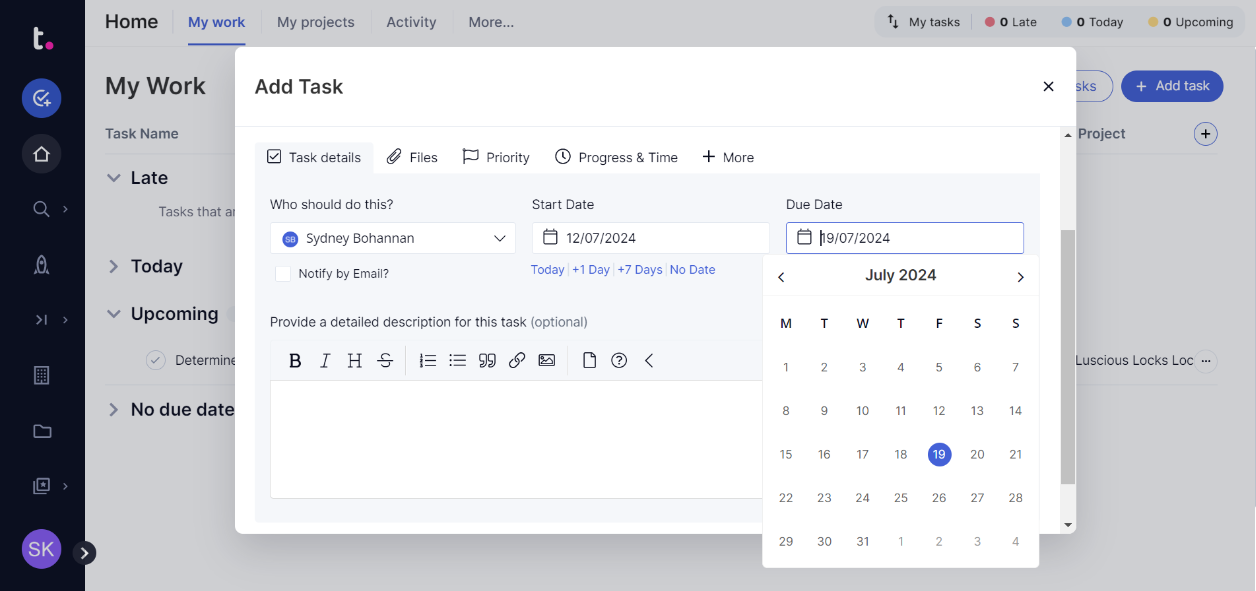
When adding tasks in TeamWork, I could add specific details like dates, team member allocation, and personalized descriptions. Source: Tech.co testing
monday.com vs ClickUp
ClickUp ranks third in our research behind monday.com and Teamwork, thanks to excellent task management and collaboration features, as well as a free plan with no user limit.
Only ClickUp performed better than monday.com when it came to overall functionality. Once you get to monday.com and ClickUp’s pricier tiers, both providers offer very similar packages — but ClickUp’s first paid plan, the $7 per user, per month Unlimited plan has far more task management, data visualization, and workflow creation tools than monday.com’s comparably priced $9 per user, per month Basic Projects plan.
ClickUp also scores better for collaboration than monday.com. ClickUp has a very advanced online whiteboard, whereas monday.com will soon be retiring this feature and directing users to a third-party product for brainstorming sessions. There’s also a chat view for instant messaging, which monday.com doesn’t offer as a native feature.
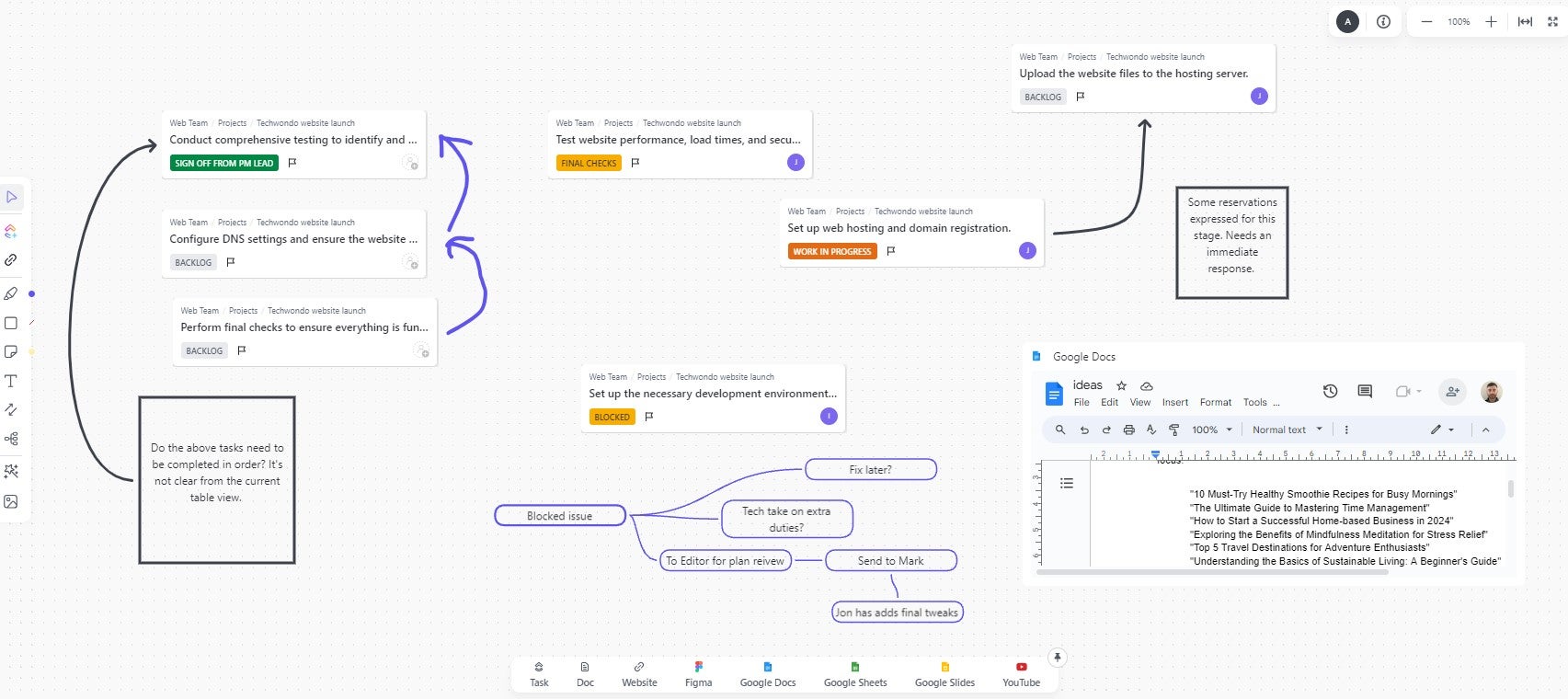
ClickUp’s online whiteboard feature will help you facilitate discussions with your team from afar in real-time. Source: ClickUp
However, ClickUp fell behind monday.com and Teamwork when it came to ease of use and customer support. monday.com improved greatly on its customer support since 2023, largely due to the fact there’s now 24/7 live support available. ClickUp, conversely, doesn’t offer this option anymore.
For a more detailed head-to-head, visit our monday.com vs ClickUp comparison page.
monday.com vs Smartsheet
Everyone in our testing group found monday.com was significantly easier to use than Smartsheet. The data import was quicker and smoother, it’s easier to switch between views and you’re able to customize them much more easily. As you can see, Smartsheet’s interface isn’t as easy on the eye:

When using Smartsheet I could comment on specific tasks to check where my team members were with their workflow. Source: Tech.co testing
“I think the [monday.com] user experience is very intuitive,” reports Stephanie Lennox, a writer who participated in our testing series. “I just guessed where I thought things would be and they ended up being there, which was great.”
“Everything is placed very carefully… a lot of thought has gone into that,” agrees Alice Martin, another business writer who took part in our ease-of-use testing and found monday.com the easiest to use. “It feels a little bit like an Apple product. You just instinctively know how to work it, which can’t be said for Smartsheet.”
For example, you can edit the size of widgets and charts like it’s an image in a Word document – you don’t have anywhere near as much freedom with Smartsheet.
For a more detailed comparison of these two platforms, check out our monday.com vs Smartsheet head-to-head.
At Tech.co, we test all of the software and services we write about in order to draw out valuable insights for those on the hunt for tools that can have transformative impacts on their businesses.
We also conduct background and market research to ensure we’re putting the top providers to the test, for content like this monday.com review. For project management software, our team identified 10 leading tools and subjected them to a rigorous assessment process, allowing us to create articles like this monday.com review. The main criteria used to judge monday.com’s plans were:
- Ease of Use – an assessment of how easy it is to perform a series of basic project management tasks.
- Customer Support – the quality of the customer support options on offer.
- Functionality – an assessment of the different types of features a provider offers, and how they function.
- Security – the quality and effectiveness of the security options on offer
- Integrations – the quality and quantity of software that a given provider integrates with
- Value for money – an assessment of how many features you get for the price you pay
We’ve got sub-criteria that we rate providers on too. For example, our “functionality” score is an amalgamation of how monday.com and other providers fared while performing Task Management, Workflow Creation, Data Visualization, and Collaboration functions.
Although we have commercial relations with some of the providers we write about, it’s our research and testing procedures that allow us to stay editorially independent. The only thing that determines our product rankings is our test results.
| Ease of Use | Pricing | Customer Support | Functionality | Security | ||||
|---|---|---|---|---|---|---|---|---|
| 4.5 | 4.3 | 4.2 | 3.9 | 4.1 | 4.1 | 3.6 | 3.2 | 3.2 |
| 3.9 | 4.4 | 3.7 | 4.4 | 3.7 | 4.1 | 4.2 | 4.8 | 4.6 |
| 4.5 | 3.8 | 4.5 | 3.3 | 4.0 | 5.0 | 4.5 | 3.5 | 2.7 |
| 4.2 | 3.7 | 4.1 | 4.6 | 3.7 | 2.9 | 3.2 | 3.1 | 3.3 |
| 5.0 | 5.0 | 4.4 | 4.3 | 5.0 | 4.4 | 4.4 | 4.2 | 4.8 |
Verdict: Is monday.com Worth It?
monday.com scores 4.7/5 overall, and it’s the best-performing project management software tool out of the 10 major providers we regularly test. If you’re looking for an easy-to-use, flexible app that can cater to a wide variety of projects, look no further than monday.com.
The provider is particularly capable when it comes to task management, with a huge range of features for viewing project progress included on the Standard plan and upwards, including custom fields, Gantt Charts, and Kanban boards. This helped monday.com to a very commendable score of 4.5/5 for this category of assessment.
Before settling on which to invest in, we’d recommend making use of the free trials offered by monday.com and Teamwork. Teamwork was one of our biggest climbers, and aside from monday.com, I found it the easiest to use. It’s not quite as powerful, but it’s worth seeing which one you prefer.
If you click on, sign up to a service through, or make a purchase through the links on our site, or use our quotes tool to receive custom pricing for your business needs, we may earn a referral fee from the supplier(s) of the technology you’re interested in. This helps Tech.co to provide free information and reviews, and carries no additional cost to you. Most importantly, it doesn’t affect our editorial impartiality. Ratings and rankings on Tech.co cannot be bought. Our reviews are based on objective research analysis. Rare exceptions to this will be marked clearly as a ‘sponsored’ table column, or explained by a full advertising disclosure on the page, in place of this one. Click to return to top of page











